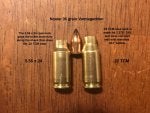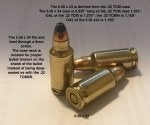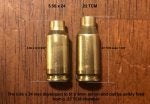Here are a few angles of my latest creation - the 5.56x24.
It is derived from the .22 TCM.
The .22 TCM was originally meant to fit in the 1911 size action with an OAL length of 1.270". Armscor got happy when they introduced the "9R" version with a proprietary, stub-nose bullet that they have never seen fit to offer for sale. The result is those who load for the .22 TCM9R in States like California where buying factory ammo can be a problem, find no ready bullet choices. The end result are bullets that must be seated too deeply for the nose ogive - even stubby 35 grain V-max bullets.
The right answer is found in a "new" cartridge case design shortened to place the case neck correctly for normal seating of the Armscor 40 grain HP. The cases are the same length to the shoulder, with the 5.56x24 case being 0.935" long and the TCM case being 1.025". Considering the bullets take up most of the shoulder region, there is little volume loss due to the different shoulder.
This round is designed to feed and function through a 9mm size magazine and chambers correctly in a standard .22 TCM chamber. On firing the case neck and shoulder will move forward and form to the TCM chamber in much the same way any other "improved" design does. Traditional "improved" chambers allow a factory case to "blow forward" to form to the shoulder. The 5.56x24 reverses this by having the forward portion of the shoulder "blow forward". The case "head spaces" perfectly in the chamber.
One possible "improvement" other than a cartridge truly made for a 9mm action is the 40 degree shoulder and forward movement of the case will likely enhance breech face thrust with a slow-burning powder. This could benefit those who want to use a simple drop-in barrel and not have to lighten their Glock slide for cycling.
Range tests will be forthcoming.
It will either blow up - not likely
The brass will fail - equally not likely
The brass will be extruded an undesirable amount - this is somewhat expected, but as with the 5.7x28 which also experiences a great deal of shoulder-neck movement, yet resizes and functions just fine, I suspect the 5.56x24 will as well, though brass life might be reduced a few times, this would not be so undesirable consider brass can be formed from .223 cases.
Accuracy MIGHT be less than desired, but since the bullet starts out in exactly the same relationship to the barrel throat as with the TCM, accuracy potential should be about the same.
![]()
![]()
![]()
![]()
It is derived from the .22 TCM.
The .22 TCM was originally meant to fit in the 1911 size action with an OAL length of 1.270". Armscor got happy when they introduced the "9R" version with a proprietary, stub-nose bullet that they have never seen fit to offer for sale. The result is those who load for the .22 TCM9R in States like California where buying factory ammo can be a problem, find no ready bullet choices. The end result are bullets that must be seated too deeply for the nose ogive - even stubby 35 grain V-max bullets.
The right answer is found in a "new" cartridge case design shortened to place the case neck correctly for normal seating of the Armscor 40 grain HP. The cases are the same length to the shoulder, with the 5.56x24 case being 0.935" long and the TCM case being 1.025". Considering the bullets take up most of the shoulder region, there is little volume loss due to the different shoulder.
This round is designed to feed and function through a 9mm size magazine and chambers correctly in a standard .22 TCM chamber. On firing the case neck and shoulder will move forward and form to the TCM chamber in much the same way any other "improved" design does. Traditional "improved" chambers allow a factory case to "blow forward" to form to the shoulder. The 5.56x24 reverses this by having the forward portion of the shoulder "blow forward". The case "head spaces" perfectly in the chamber.
One possible "improvement" other than a cartridge truly made for a 9mm action is the 40 degree shoulder and forward movement of the case will likely enhance breech face thrust with a slow-burning powder. This could benefit those who want to use a simple drop-in barrel and not have to lighten their Glock slide for cycling.
Range tests will be forthcoming.
It will either blow up - not likely
The brass will fail - equally not likely
The brass will be extruded an undesirable amount - this is somewhat expected, but as with the 5.7x28 which also experiences a great deal of shoulder-neck movement, yet resizes and functions just fine, I suspect the 5.56x24 will as well, though brass life might be reduced a few times, this would not be so undesirable consider brass can be formed from .223 cases.
Accuracy MIGHT be less than desired, but since the bullet starts out in exactly the same relationship to the barrel throat as with the TCM, accuracy potential should be about the same.























